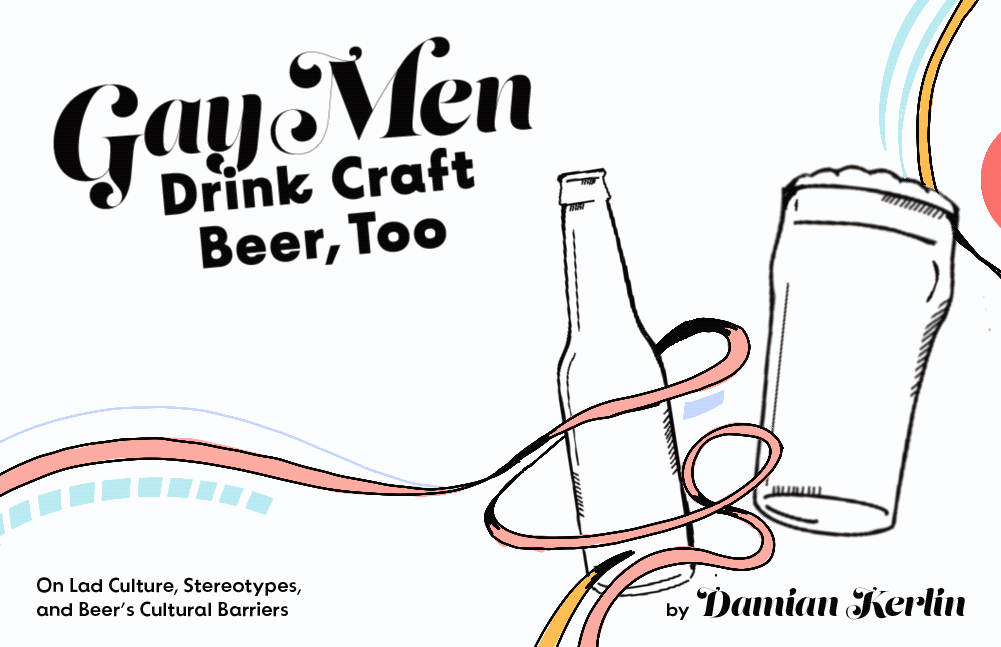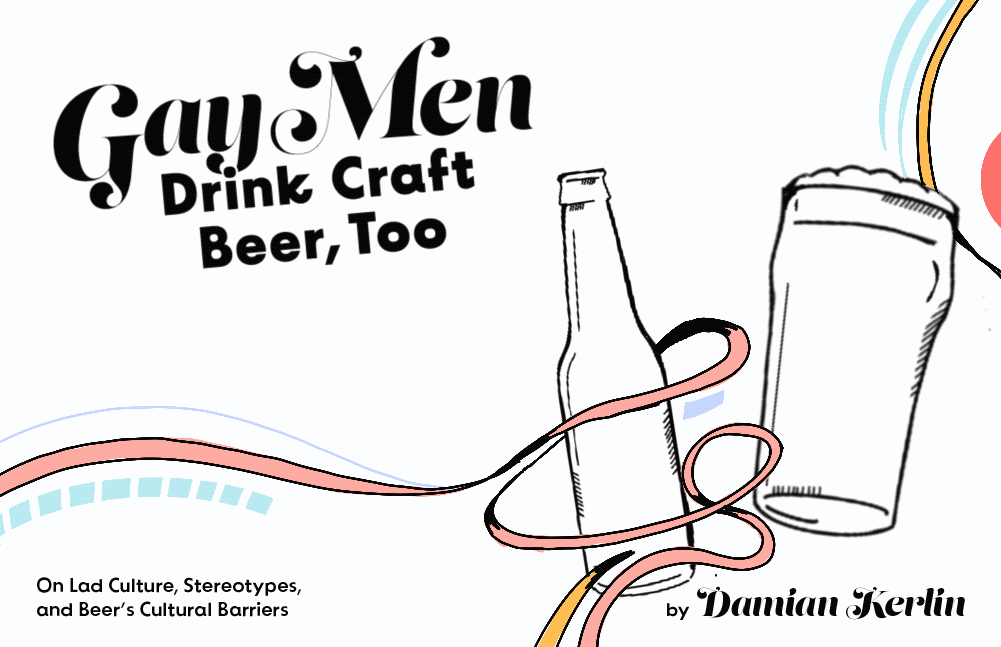My first introduction to beer was through my dad: When I was young, I used to ask for a sip from a freshly opened bottle. I liked it cold—the colder the better. But as I got older, I stopped drinking beer and instead ordered what felt representative of me: vodka and Coke, gin and tonic, wine.
I wasn’t aware of it at the time, but now that I’m older, I understand why my drinking preferences changed. It’s not because I stopped liking beer—instead, I wanted to fit in with my peers, those who I drank with and wanted to emulate. I came to see beer as macho, laddy and rough, just like vodka and Coke was chic, sophisticated. Even the glasses in which the two were served seemed to confirm that: one a chunky pint glass, the other a small, light tumbler.


If I did drink beer, I stuck to bottles as opposed to pints, in keeping with the persona I wanted to cultivate. This was my compromise, my middle ground. It’s strange to think that a drink can feel representative of your identity, of how you want to be perceived. But to me and many of my LGBTQ+ friends, it did. Beer just didn’t feel like it was meant for me.
Today, that’s changed: I drink pints and order craft beers when I go out. I’m no longer single; perhaps those pints signify that I’m now settled and comfortable, while picking craft brands is a way of expressing sophistication, of thinking differently. I’m well aware of the stereotype associated with what I’m drinking, but I’m telling the world that I simply don’t care anymore. I also better understand all the reasons I was convinced that beer wasn’t meant for me in the first place.
Many of the LGBTQ+ people I spoke to for this piece reported coming to beer the same way their heterosexual counterparts did. We were teenagers, sipping family members’ pints at weddings or birthdays. M, a taproom manager in Edinburgh, says their first taste of beer “was [at] Christmas, and my uncle offered me a sip of his V.B., a very cheap Australian beer.” “Much like smoking, it was more about the thrill of the experience,” says Matt Fox, a PR consultant based in London.
However, among the gay men I spoke to, there was an early awareness that beer was “a man’s drink.” As I was growing up, I had a heightened sense of what was “manly” and what wasn’t, an acute awareness that my interests did not align with what I was told I should enjoy. And beer was always manly. You would only have to watch TV to see beer adverts aimed at straight men, or look at photos in national publications of pints being consumed by men staggering out of sport stadiums, to understand that. When you see a drink associated with interests that are opposed to yours, you unconsciously learn to avoid it.
I’m certainly not the only one who picked up on those cultural barriers. The Gender Pint Gap report identifies mainstream beer’s marketing tactics, and its reliance on male-dominated advertising, as one of the main reasons why only 17% of women drink beer weekly compared to 53% of men. Queer drinkers didn’t even factor into this equation, due to lack of representation in beer adverts. (That started to change in the late 1990s, when Budweiser took out an ad in an issue of EXP showing two men holding hands, though that representation is still fractional.)
Of the LGBTQ+ drinkers I spoke to, an overwhelming majority felt that in crowded, non-LGBTQ+ venues, they ordered drinks which they felt others—straight people—would expect of them. For gay men, that meant choosing drinks that fit the hyper-camp and feminised characters portrayed on TV, or for lesbians, a pint of Ale—the darker and stronger the better. The aim is “to fall in line,” “raise no eyebrows,” and even ensure personal safety. In the case of gay men who would otherwise order a pint, there is the very real fear of emasculating someone who might react badly if they were seen drinking the same thing.
I’m familiar with these pressures and expectations. I love a beer, but a personality test in a glossy magazine would match me with a Cosmopolitan. Maybe the giant orange slice I demand in my Blue Moon gets me halfway there. But why does one still feel more acceptable than the other?
For many, the answer—or at least one of the answers—is lad culture. In the Observer, Eva Wiseman described lad culture as “a subset of beer drinking that promotes one particular masculinity—one expressed through hard drinking and hard bantering; one that normalises sexual harassment; one that exaggerates this masculinity in the face of any threat to it.” Think of it as the U.K.’s answer to frat culture, and no less toxic.
These descriptions were backed up by a report on lad culture from Sussex University. Over 50% of the women students polled identified “prevailing sexism, ‘laddism’ and a culture of harassment” at their universities. In those contexts, the consumption of beer en masse is largely associated with initiation rituals around male-dominated sports teams or social groups. But those attitudes fostered in a student context don’t suddenly dissipate after graduation.
“It can be incredibly intimidating as a gay man,” says Shaun Houcke, owner of The Glory Stores in Cardiff. “To walk into a bar, full of straight men, drinking pints. If you can pass as straight you are one of the lucky ones, as you can order a pint and come away unscathed, but many find themselves ordering what is expected of them, which raises no questions but does not avert the gazes and taunts.”
I’ve felt the impact of lad culture when I’ve been out with my girlfriends, and ordered a glass of wine (or two) to blend in. I’ve felt it every time I’ve been told “it’s just bants,” or that I “can’t take a joke,” which is easy to say when you’re not the brunt of it—but for many of us, we have grown up with those taunts, those “jokes.” And I’ve felt it in my now-choreographed response: I’ll step in line, do what is expected of me, and stay quiet.


Lad culture’s beery, shouty voice can feel like it dominates wide swaths of British drinking and social spaces. Making room for LGBTQ+ people, by contrast, feels like the last priority for many beer-oriented brands and venues. You only have to look at the World Cup, which this year is being held in Qatar—a country that represses the rights of LGBTQ+ people, and punishes same-sex relations with up to seven years in prison—for an example. The event is sponsored by Budweiser, which appears to have forgotten about its supposed allegiance with the LGBTQ+ community; it was only too happy to shout about that with its limited-edition rainbow branding during Pride month.
This othering happens on a macro level, and also, routinely, on a micro level. “I have absolutely felt like an anomaly on many occasions,” says Matt Fox. “I’ve had several experiences in Soho and Clapham bars that made me feel like I’m either not drinking beer properly or that my drinking choices are out of the ordinary. ‘You can’t drink beer at a nightclub,’ or, ‘OMG, you want a beer?’—the side-eyes and furrowed brows have become a norm. Pint in hand, I do sometimes feel a bit laddy, but I attribute this feeling more so to British pub culture.”
As a marketeer, a common misconception is that everyone is your target audience. If this is the case, your campaign will fall short, and fail to deliver results. There is no “right” message for everyone; as you broaden your audience, you dilute the message. Clever marketing identifies a target audience—but cleverer marketing doesn’t exclude everyone else while doing so.
The LGBTQ+ community witnesses this phenomenon every June when the rainbows come out (pun intended)—seemingly the one time of year when beer marketing is allowed to engage with queer drinkers. Suddenly, major brands and stores are filled with multi-coloured displays and clothes emblazoned with “Love Is Love.” Corporations can’t wait to exploit Pride Month as a marketing exercise, all with ill-advised and clunky campaigns that fail to speak to actual LGBTQ+ people. Instead, this Pride rebranding reflects the power of the pronoun pound, but it would be better if corporations were honest about their intentions without the performative progressivism.


If these Pride missteps offer a lesson, it’s that there is always a fine line between catering to your target audience while ensuring not to alienate another. As we know, beer marketing has historically targeted only a certain type of masculinity, with women portrayed in subservient roles, and people of colour and LGBTQ+ folks excluded almost entirely.
“Mass-produced supermarket beer is often marketed towards men and paired with sport, which can alienate the LGBTQI+ community and women, and a great deal of pubs have a brutish quality that I personally wouldn’t revel in,” M said. “I think many older members of the community have seen or endured years of pubs filled with homophobic punters with managers and staff not willing to protect them and they now paint all ‘non-queer’-branded spaces with the same apprehensive brush.”
But is that now starting to change? In his debut book, “Gay Bar: Why We Went Out,” essayist Jeremy Atherton Lin writes, “Over the past couple of years, I’ve noticed standard pubs around South London have begun hoisting rainbow flags. At the sight of the first one, which I passed regularly on the bus, I turned different scenarios over in my head: Maybe it had been flown for Pride month and never taken down. Then other pubs started doing the same […] Maybe the flags weren’t just inviting us in but keeping certain other types at bay. Maybe the flag, which once proclaimed what a bar is, now proclaims what it isn’t — a place for hooliganism, violence, machismo. We don’t want trouble here, the flag now signals. Cheaper than a bouncer.”
Some publicans confirm this approach. “Owners have admitted to hanging the Pride flag to deter certain clientele,” Shaun says. “Clientele who may have biased views, or be looking to start trouble. Nobody wants that. By demonstrating you are ‘inclusive,’ you are basically saying, ‘We won’t put up with that here.’ Whether they stand by that, is a different story.”
Fortunately, as equality has progressed for marginalised groups, we are much freer to enjoy a beer in non-LGBTQ+ venues, whether at their core they’re inclusive or not.
But it still feels hard to find LGBTQ+ venues built around beer-drinking, particularly outside of large cities like London. In Cardiff, where I live, the scene is much smaller, and bars tend to be more music- and entertainment-focused. As much as I love a dance, now that I have two kids in tow, I’m looking for somewhere I can sit and have a chat without having to shout.


Instead, I now tend to frequent bars local to me. Cardiff has seen a number of small, independent bars pop up across the outskirts of the city, which are gaining support from local residents. Many community pubs have since been bought out by large breweries and pub companies, robbing them of their local feel; these independents are catering to that need for community instead. That welcoming feel, knowing that I’ll regularly see the same faces, means I no longer care if people think I’m chic with my vodka and Coke. I’m able to consume my drink of choice—usually a craft beer, gluten-free if possible—with friends and family, and without worry.
That progression has happened slowly but surely, and I don’t think it’s unique to Cardiff. I’m seeing more discussions about representation in the industry. And as a marketer, I’m seeing this awareness more among clients, who are making less stereotypical assumptions about their audiences. Being proactive is so important when building trust with drinkers of different backgrounds. As one of the drinkers, I don’t expect anyone to get it right every time—but coming on that journey with us is a great start.
Ultimately, it’s about wobbling the dominating culture by pointing out that it’s actually one of many much more positive and inclusive cultures. That it is challengeable. Speak-up-against-able. So that the LGBTQ+ community in its entirety realises that it’s possible to swim against it, stand up to it, and cheers whatever drink we damn well choose.










